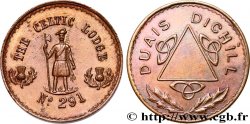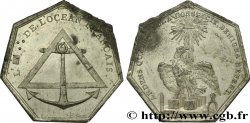fme_582098 - FREEMASONRY Médaille, La concorde, Orient de Sens
60.00 €约 502.80 CNY
数量
加入购物车

种类 Médaille, La concorde, Orient de Sens
日期: n.d.
材质 bronze
直径 56 mm
模子方针 12 h.
侧面 lisse + 3.7.77 + CY 095
关于品相的说明
Patine sombre hétérogène. Présence de coups et rayures sur les rebords
出版目录中的项代码 :
正面
正面的文字 LA CONCORDE / OR:. / DE SENS / 5777 (TRIANGLE) 5977 / G:. O:. D:. F:..
正面的说明书 Légende en 5 lignes au dessus de branches de chêne et aubépine.
背面
背面的文字 DEUX SIECLES DE RECOMPENSE DU TRAVAIL.
背面的说明书 G dans un triangle rayonnant.
评论
Nous savons grâce à l’ouvrage de Marc Labouret que cette loge fut établie par le Grand Orient en 1777 mais que ses travaux s’interrompirent avant 1789 et ne reprirent qu’en 1808. La loge semble toujours exister.
La franc-maçonnerie s’implante en France aux alentours du premier quart du XVIIIe s. sous l’influence d’aristocrates anglais. Initiatique, elle est fondée sur le rite hiramique, du nom d’Hiram de Tyr, personnage biblique, architecte du roi Salomon sur le chantier du Temple et qui a résisté à la torture sans livrer ses secrets. Hiram a aussi donné un point de départ du calendrier maçonnique commençant 4000 ans avant le calendrier chrétien. Les symboles servent de signes de reconnaissance entre les initiés, notamment des outils de constructeur de cathédrales (équerre, compas, niveau, maillet, etc.), des formes (triangle, étoile), des nombres (trois, cinq, sept) et des lettres.
We know from Marc Labouret's work that this lodge was established by the Grand Orient in 1777, but that its work was interrupted before 1789 and did not resume until 1808. The lodge still appears to exist. Freemasonry was established in France around the first quarter of the 18th century under the influence of English aristocrats. An initiatory practice, it is based on the Hiramic rite, named after Hiram of Tyre, a biblical figure who was King Solomon's architect on the construction site of the Temple and who withstood torture without revealing his secrets. Hiram also provided a starting point for the Masonic calendar, which began 4,000 years before the Christian calendar. Symbols serve as signs of recognition between initiates, including cathedral builder's tools (square, compass, level, mallet, etc.), shapes (triangle, star), numbers (three, five, seven), and letters.
La franc-maçonnerie s’implante en France aux alentours du premier quart du XVIIIe s. sous l’influence d’aristocrates anglais. Initiatique, elle est fondée sur le rite hiramique, du nom d’Hiram de Tyr, personnage biblique, architecte du roi Salomon sur le chantier du Temple et qui a résisté à la torture sans livrer ses secrets. Hiram a aussi donné un point de départ du calendrier maçonnique commençant 4000 ans avant le calendrier chrétien. Les symboles servent de signes de reconnaissance entre les initiés, notamment des outils de constructeur de cathédrales (équerre, compas, niveau, maillet, etc.), des formes (triangle, étoile), des nombres (trois, cinq, sept) et des lettres.
We know from Marc Labouret's work that this lodge was established by the Grand Orient in 1777, but that its work was interrupted before 1789 and did not resume until 1808. The lodge still appears to exist. Freemasonry was established in France around the first quarter of the 18th century under the influence of English aristocrats. An initiatory practice, it is based on the Hiramic rite, named after Hiram of Tyre, a biblical figure who was King Solomon's architect on the construction site of the Temple and who withstood torture without revealing his secrets. Hiram also provided a starting point for the Masonic calendar, which began 4,000 years before the Christian calendar. Symbols serve as signs of recognition between initiates, including cathedral builder's tools (square, compass, level, mallet, etc.), shapes (triangle, star), numbers (three, five, seven), and letters.








 对产品描述纠错
对产品描述纠错 打印
打印 分享我的选择
分享我的选择 提问
提问 Consign / sell
Consign / sell
 产品介绍
产品介绍










